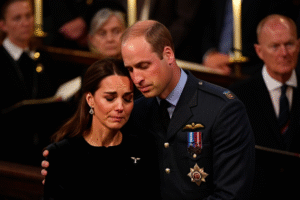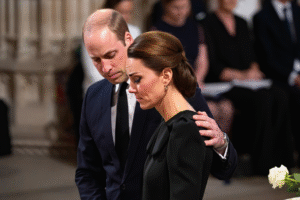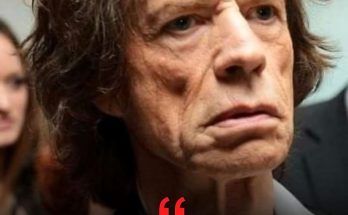The image stunned millions. A single tear, sliding down the pale cheek of the Princess of Wales, told a story words could never capture. Kate Middleton, usually the very definition of composure and grace, appeared visibly worn, her face marked by exhaustion as she stood by her husband, Prince William. In that fleeting moment, as her tear fell and her body leaned into William’s steady shoulder, the world saw not just a royal figure — but a woman carrying the unbearable weight of remembrance, duty, and loss.

This month has been nothing short of relentless for the princess. From orchestrating preparations for the memorial of Princess Diana, to honoring the late Queen Elizabeth II, and finally paying respects at the solemn funeral of the Duchess of Kent, Kate has devoted her time, her heart, and her strength to the Crown. Every gesture, every public appearance, demanded composure. Yet behind the scenes, it demanded sacrifice.

Royal watchers note how deeply personal these ceremonies must have been for her. Diana’s memorial brings the unhealed wounds of William’s youth into the spotlight — wounds Kate has long helped him bear. The Queen’s remembrance is a constant reminder of the towering legacy they are expected to uphold. And the loss of the Duchess of Kent represents the fading of an entire generation, leaving William and Kate as the steady faces of a monarchy that grows older by the day.
It was during the final service of the month that Kate’s mask slipped. Cameras caught her eyes glistening, her lips trembling as she bowed her head. Then came the tear — small, fragile, yet heavy with meaning. As it traced her cheek, Kate instinctively leaned against William, who placed a protective arm around her. For once, the world wasn’t watching a royal couple perform their duty. They were watching a husband and wife, holding on to each other in the storm.

The moment spread like wildfire across social media. “She looks so tired, my heart breaks for her,” wrote one user on X (formerly Twitter). Another remarked, “That tear is more powerful than any royal speech. It shows us she’s human.” Thousands of comments echoed similar sentiments: admiration for her strength, sympathy for her exhaustion, and praise for William’s steadfast presence.
But as with anything royal, the scene also sparked controversy. Critics questioned whether such emotion should be displayed publicly, arguing that the monarchy thrives on dignity and restraint. “A queen cannot afford to cry in public,” one commentator wrote. Yet supporters countered that Kate’s vulnerability was precisely what makes her beloved. “She’s not a porcelain doll. She’s a wife, a mother, and now the backbone of the royal family,” another post argued.

What cannot be denied is the symbolism. In that tear, many saw the pressures of history weighing down on her — Diana’s memory, Elizabeth’s shadow, the constant gaze of the public. In William’s embrace, they saw the future: a man prepared to shield his partner, just as she has shielded him.
Royal insiders say the couple’s bond has only deepened through this month of sorrow. “Kate gives William strength when he is forced to face his mother’s ghost,” one source revealed. “This time, it was William’s turn to be her rock.”
And so, the photograph of Kate in tears has come to define not just a moment, but an era. The monarchy, once rigid and untouchable, now shows cracks of humanity. For some, it’s a sign of weakness. For many more, it’s proof that the royals can still connect to ordinary hearts.
As Britain reflects on its past, the world cannot look away from the Princess of Wales — fragile, exhausted, yet still dignified. A tear on her cheek, a shoulder to lean on, and a love story unfolding in plain sight.



